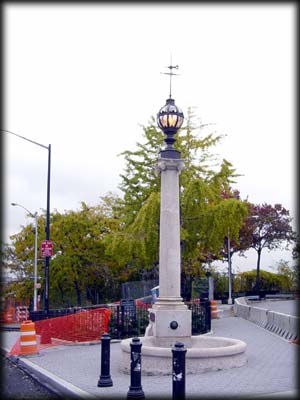Hooper Fountain
Maher Circle
Who is this fountain named for?
This fountain is named for its benefactor, civic-minded businessman John Hooper (1812–1889). Having left the United States Military Academy at West Point after two years, Hooper went to work as a civil engineer during the construction stages of the New York and Erie Railroad in the 1840s. He then joined Horace Greeley’s New York Tribune, where he began what was claimed to have been the first advertising agency in New York.
Hooper used the connections he made at the Tribune to go on to become a successful businessman. The one-time director of the Iron Steamboat Company, Hooper also served as president of the Colwell Lead Company and the North River Savings Bank. Hooper owned extensive real estate in New York and Brooklyn, was a trustee of the Tribune Association, and supported many charitable institutions in the New York area.
When Hooper died in 1889, he willed the cities of Brooklyn and New York $5,000 each to construct two fountains “whereat man and beast can drink.”
How was this fountain created?
The Washington Heights Association augmented Hooper’s gift, paying for the foundation, and the simple yet elegant fountain was completed in 1894. (The other fountain in Brooklyn was built at Flatbush and Sixth Avenue near Hooper’s home but dismantled long ago.) This ornamental drinking fountain, designed by architect George Martin Huss, consists of a large round horse trough, a scalloped drinking fountain for humans, two small side basins for dogs, and a central Ionic column topped by a decorative globe-shaped lantern. Bronze lion heads adorn the water spouts.
When the pink granite fountain was erected, the streets of Manhattan were frequented by thousands of horses daily—equine transport being the principal means of conveying goods throughout the city. Numerous watering fountains and troughs were found along thoroughfares and traffic intersections. Many were erected by humane societies such as the American Society for the Prevention of Cruelty to Animals (ASPCA) and besides serving the health of beasts of burden, these roadside fountains often exhibited a degree of artistry. The decline of horse-drawn commercial vehicles resulted in the virtual elimination of these fountains by World War II.
Having long lost its original function, in 1935 parks officials considered relocating the fountain to an appropriate spot along a bridle path. “Horse and sturdy ox have vanished in a cloud of gasoline exhalations,” said a Parks official. “[The fountain] stands there in the traffic with the serene inconsequence of a megatherium [sic] on Broadway.” The plan went unrealized and in 1981 vandals toppled the shaft, damaged its capital, and destroyed the lantern on top; the remaining elements were salvaged and stored.
In 1992, the New York City Landmarks Preservation Commission designated the Macombs Dam Bridge, 155th Street Viaduct, and Maher Circle, which encompasses the Hooper Fountain, as an official landmark. The metal-truss swing bridge, a marvel of modern engineering, was built between 1890 and 1894 under the auspices of the New York City Department of Public Works and the Department of Public Parks. It is the third oldest major bridge and the oldest of its type in New York City. Maher Circle was named after Lieutenant Joseph F. Maher, a resident of Washington Heights who was killed at the Battle of Belleau Woods in France during the First World War.
The Hooper Fountain was restored in 2001 by the Department of Transportation and NYC Parks, as part of the reconstruction of the bridge and viaduct. The column and basins, including the plumbing, were repaired and the long-missing lion-head spouts, lantern, weathervane, and bronze dedicatory plaque were recreated.
Thursday, May 02, 2024
